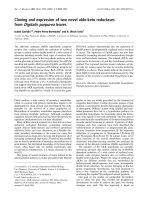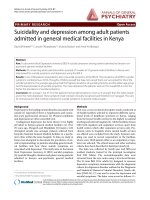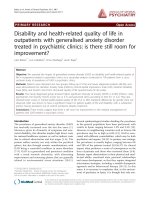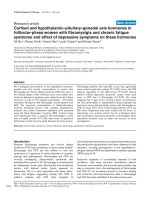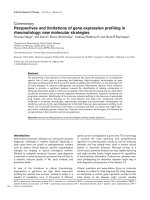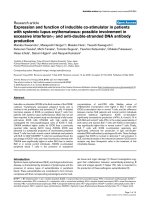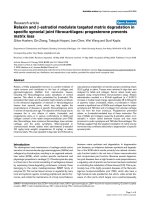Báo cáo y học: "Suicidality and depression among adult patients admitted in general medical facilities in Kenya" potx
Bạn đang xem bản rút gọn của tài liệu. Xem và tải ngay bản đầy đủ của tài liệu tại đây (508.48 KB, 6 trang )
Ndetei et al. Annals of General Psychiatry 2010, 9:7
/>Open Access
PRIMARY RESEARCH
© 2010 Ndetei et al; licensee BioMed Central Ltd. This is an Open Access article distributed under the terms of the Creative Commons
Attribution License ( which permits unrestricted use, distribution, and reproduction in
any medium, provided the original work is properly cited.
Primary research
Suicidality and depression among adult patients
admitted in general medical facilities in Kenya
David M Ndetei*
1,2
, Lincoln I Khasakhala
1,2
, Victoria Mutiso
1
and Anne W Mbwayo
1
Abstract
Aim: To document Beck Depression Inventory (BDI) II suicidal symptoms among patients admitted to Kenyan non-
psychiatric general medical facilities
Methods: All consenting adults admitted within a period of 4 weeks at 10 general medical facilities in Kenya were
interviewed for suicidal symptoms and depression using the BDI-II.
Results: In all, 2,780 patients responded to item 9 (suicidal symptoms of the BDI-II). The prevalence of all BDI-II suicidal
symptoms combined was 10.5%. Thoughts of 'killing oneself but have not carried them out' accounted for 9% of the
suicidal symptoms. The younger age group had the highest prevalence of suicidal symptoms and the oldest age group
had the least prevalence of suicidal symptoms. The more depressed the patients were on the overall BDI-II score, the
higher the prevalence of suicidal symptoms.
Conclusion: On average 1 out of 10 of the patients had suicidal symptoms, more so in younger than the older people
and in the more depressed. These symptoms had not been clinically recognised and therefore not managed. This calls
for clinical practice that routinely enquires for suicidal symptoms in general medical wards.
Background
Depression is the leading mental disorder associated with
suicide [1] especially if there is hopelessness and comor-
bid acute psychosocial stressors [2]. Physical conditions
and depression are often comorbid [3,4]
Undiagnosed depression has been shown to be highly
prevalent in Kenyan general medical facilities [4]. Over
25 years ago, Mengech and Dhadphale [5] found a 3.4%
attempted suicide rate amongst patients referred from
Kenyatta National General Medical facilities to a psychi-
atric clinic within the same hospital. To date, no study in
Kenya has attempted to document the prevalence of sui-
cide symptomatology in patients attending general medi-
cal facilities and how these suicide symptoms are
associated with depression. This study aims to document
Beck Depression Inventory-II (BDI) suicidal symptoms
[6] (suicidal thoughts, ideation and plans) among patients
admitted to Kenyan non-psychiatric general medical
facilities.
Methods
This was a cross-sectional descriptive study conducted at
10 health facilities selected to represent different opera-
tional levels of healthcare provision in Kenya, ranging
from the lowest (health centres) to the highest (a national
teaching and referral hospital) [4]. All the facilities chosen
offer both inpatient and outpatient services, apart from
health centres which offer outpatient services only. Psy-
chiatric units in hospitals where mental health services
are offered were excluded from the study. Systemic sam-
pling was used to recruit respondents in the facilities,
where every third patient either as an outpatient or inpa-
tient was selected. The ethical issues and other exclusion
criteria have been described in detail previously [4].
The data was collected by fourth-year and fifth-year
medical students trained by the principal investigator,
Prof DM Ndetei. The sociodemographic data were
extracted from the case notes using a structured format.
The 21-item BDI II for adults [6], designed to measure
depressive symptoms commensurate with the diagnostic
criteria for depressive disorder outlined in the Diagnostic
and Statistical Manual of Mental Disorders, fourth edi-
tion (DSM-IV), [7] was used to score for depression and
suicidal symptoms. The latter were scored as follows: 0 =
* Correspondence:
1
Africa Mental Health Foundation, Nairobi, Kenya
Ndetei et al. Annals of General Psychiatry 2010, 9:7
/>Page 2 of 6
I don't have any thoughts of killing myself; 1 = I have
thoughts of killing myself but have not carried them out;
2 = I would like to kill myself; 3 = I would kill myself if I
had the chance.
The cut-off points on the BDI-II for mild to severe
depression applied in this study were those cut-off points
for patients with physical conditions in medical facilities
[8 m 9]. Descriptive statistics were generated using SPSS
version 16 (SPSS, Chicago, IL, USA).
Results
Response rate
A total of 2,797 respondents were recruited into the
study, with full sociodemographic data for 2,780 (99.4%)
respondents extracted from the case notes. They were
also able to complete question 9 on the BDI-II. In all,
91.5% (n = 2,543) of respondents completed the whole
BDI-II.
Sociodemographic variables and suicide symptoms
The severities of suicidal symptoms according to the
sociodemographic variables of the 2,780 patients who
responded to item 9 with the 4 possible scores (that is, 0,
1, 2, 3) for suicide symptoms are summarised in Table 1.
The overall prevalence of suicidal symptoms (scores 1,
2 and 3) was 10.5% (n = 291), with the frequency decreas-
ing from scores of 1 to 3.
The highest prevalence of 14.5% suicidal symptoms was
in the youngest age group (18 to 20) and least (8.0%) in
those over 75 years. The genders were similar. The Cath-
olic religion had the least prevalence, of 7.1%. Divorced
marital status had the highest prevalence (20.7%) as
opposed to 7.9% in the married group. No education or
low levels of education had the least prevalence at 3.7%
compared to other levels of education. Having no chil-
dren and having few children (1 to 2 children) was associ-
ated with a higher prevalence of suicide symptoms.
Table 2: Total Beck Depression Inventory (BDI)-II scores vs severity of suicide symptoms
BDI-II score Total of
1,2,3
Total P valuea
No Yes
0123
0 to 13: no
depression
1,875
(96.1%)
73 (3.7%) 3 (0.15%) 1 (0.05%) 3.9 1,952
(100%)
χ
2
=
6.976E
2a
, df
= 9, P <
0.000
14 to 19:
mild
depression
270 (81.1% 57 (17.1%) 3 (0.9%) 3 (0.9%) 18.9 333 (100%)
20 to 28:
moderate
depression
127 (67.9%) 56 (30%) 3 (1.6%) 1 (0.5%) 32.1 187 (100%)
29 to 63:
severe
depression
23 (32.4%) 29 (40.8%) 10 (14.1%) 9 (12.7%) 67.6 71 (100%)
Total 2,295
(90.2%)
215 (8.5%) 19 (0.7%) 14 (0.6%) 2,543
(100%)
BDI-II scores: 0 = I do not have thoughts of killing myself; 1 = I have thoughts of killing myself, but I'd not carry them out; 2 = I'd like to kill
myself; 3 = I'd kill myself if I had a chance.
a
Frequency of suicide symptoms significantly increased with severity of depression.
df = degrees of freedom.
Ndetei et al. Annals of General Psychiatry 2010, 9:7
/>Page 3 of 6
Table 1: Beck Depression Inventory (BDI)-II suicidal symptoms according to sociodemographic characteristics, n (%)
BDI-II score Total P value
0123
Age in years:
18 to 20 247 (85.5%) 36 (12.5%) 3 (1%) 3 (1%) 289 (10.4%) NS
21 to 25 533 (90.8%) 45 (7.7%) 6 (1.0%) 3 (0.5%) 587 (21.1%)
26 to 30 530 (89.8%) 54 (9.2%) 2 (0.3%) 4 (0.7%) 590 (21.2%)
31 to 45 701 (88.6%) 80 (10.1%) 6 (0.8%) 4 (0.5%) 791 (28.5%)
46 to 60 351 (91.1%) 25 (6.5%) 6 (1.6%) 3 (0.8%) 385 (13.9%)
61 to 75 104 (92.0%) 8 (7.1%) 0 (0%) 1 (0.9%) 113 (4.1%)
>75 23 (92%) 1 (4%) 1 (4%) 0 (0%) 25 (0.9%)
Total 2,489 (89.5%) 249 (9.0%) 24 (0.9%) 18 (0.6%) 2,780 (100%)
Sex:
Male 1,148 (89.4%) 116 (9.0%) 12 (1%) 8 (0.6%) 1,284 (46.2%) NS
Female 1,341 (89.6%) 133 (8.9%) 12 (0.8%) 10 (0.7%) 1,496 (53.8%)
Total 2,489 (89.5%) 249 (9.0%) 24 (0.9%) 18 (0.6%) 2,780 (100%)
Religion:
Christian 2,293 (89.9%) 217 (8.5%) 22 (0.9%) 15 (0.7%) 2,547 (91.6%) χ
2
= 38.765, df
= 12, P < 0.000
Muslim 87 (82.8%) 15 (14.3%) 1 (1%) 2 (1.9%) 105 (3.8%)
Catholic 89 (92.7%) 6 (6.3%) 0 (0%) 1 (1%) 96 (3.5%)
Hindu 2 (50%) 2 (50%) 0 (0%) 0 (0%) 4 (0.1%)
Others 18 (57.1%) 9 (32.1%) 1 (3.8%) 0 (0%) 28 (1.0%)
Total 2,489 (89.5%) 249 (9%) 24 (0.9%) 18 (0.6%) 2,780 (100%)
Ndetei et al. Annals of General Psychiatry 2010, 9:7
/>Page 4 of 6
Total score on BDI-II vs severity of suicide symptoms
A total of 2,543 participants completed all the items of
BDI-II including item 9, thus allowing crosstabulation of
degree of severity of depression and the different scores
for item 9 (suicide symptoms) (Table 2).
Among the patients who scored for mild depression on
the BDI-II (total score of 14 to 19), 18.9% (n = 63) had sui-
cidal symptoms of varying severity; those who scored for
moderate depression (total score of 20 to 28), 32.1% had
suicidal symptoms of varying degrees, but majority
(67.5%) n = 48 who had severe depression (score of >28)
had suicidal symptoms whereas of those who had normal
scores (total score of 0 to 13) on the BDI-II only 3.9% (n =
77) had suicidal symptoms.
Discussion
The findings of this study must be considered in light of
various caveats. First, this was a cross-sectional study in
Marital status:
Single 863 (88.3%) 99 (10.1%) 10 (1%) 5 (0.6%) 977 (35.1%) χ
2
= 48.453, df
= 18, P < 0.000
Married 1,499 (91.0%) 129 (8.8%) 11 (0.7%) 8 (0.5%) 1,647 (59.2%)
Polygamous 33 (84.6%) 5 (12.8%) 0 1 (2.7%) 39 (1.4%)
Cohabiting 14 (77.7%) 3 (16.7%) 1 (5.6%) 0 (0%) 18 (0.6%)
Separated 55 (86.0%) 6 (9.3%) 1 (1.6%) 2 (3.1%) 64 (2.3%)
Divorced 20 (69.0%) 6 (20.7%) 1 (3.4%) 2 (6.9%) 29 (1.0%)
Widowed 5 (83.3%) 1 (16.7%) 0 (0%) 0 (0%) 6 (0.2%)
Total 2,489 (89.5%) 249 (9%) 24 (0.9%) 18 (0.6%) 2,780 (100%)
Level of
education:
None 83 (94.3%) 5 (5.7%) 0 (0%) 0 (0%) 88 (3.2%) NS
Primary 831 (89.6%) 81 (8.7%) 8 (0.9%) 7 (0.8%) 927 (33.3%)
Secondary 1,025 (88.7%) 112 (9.7%) 9 (0.8%) 9 (0.8%) 1,155 (41.5%)
College 458 (90.3%) 43 (9.5%) 5 (1.3%) 1 (0.2%) 507 (18.2%)
University 92 (89.3%) 8 (7.8%) 2 (1.9%) 1 (1%) 103 (3.7%)
Total 2,489 (89.5%) 249 (9%) 24 (0.9%) 18 (0.6%) 2,780 (100%)
BDI-II scores: 0 = I do not have thoughts of killing myself; 1 = I have thoughts of killing myself, but I'd not carry them out; 2 = I'd like to kill
myself; 3 = I'd kill myself if I had a chance. Education: primary = 1 to 8 years of formal education; secondary = 9 to 12 years of formal education;
college and university = post secondary education.
df = degrees pf freedom; NS = not significant.
Table 1: Beck Depression Inventory (BDI)-II suicidal symptoms according to sociodemographic characteristics, n (%)
Ndetei et al. Annals of General Psychiatry 2010, 9:7
/>Page 5 of 6
patients being managed for medical conditions. The
nature of the medical conditions and the severity of those
conditions could have had an effect on the severity of
either or both the depression and the suicidal symptoms.
It is therefore conceivable that the severity of the depres-
sion and the symptoms of suicide would have varied if
these were pegged to specific medical conditions and on
varying severity of those specific physical conditions.
Further, the severity of the depression and the suicidal
symptoms could vary with duration of a given specific
condition. The findings of this study can therefore at best
be regarded as a cumulative average dependent on multi-
ple factors.
In mitigation however, this study was primarily focused
on the prevalence of suicidal symptoms and not associa-
tion with specific underlying diagnosis, whether psychi-
atric and/or physical diagnoses or neither. Further,
depression is the commonest cause of suicide symptoms
and given that these patients were being managed by
non-psychiatrists, the BDI-II was chosen as the screener
for depression because it has been found to be useful in
general non-psychiatric facilities [8,9] and can be self-
administered or administered by non-psychiatrist.
A further limitation of this study is the fact that item 9
of the BDI-III contributes to the overall scoring for BDI-
II, although it was selected to gauge how it is associated
with overall depression. Another limitation is that the
psychometric properties of the BDI-II in the Kenyan
sociocultural context, and more specifically in general
medical settings, have not been described, but this is mit-
igated by the fact that the BDI-II has been used exten-
sively in similar settings and producing results similar to
those found in other parts of the world studying similar
psychiatric populations [4]. When suicidal ideation is
taken alone, the 9.0% prevalence is similar to the 9.1%
prevalence in general medical facilities in South Africa
[10].
On a positive note, the response rate for all variables
was high, suggesting a high interest in patients to partici-
pate. This was despite the fact that voluntary and
informed consent was obtained from all those who were
well enough [4], and were therefore under no obligation
to participate in the study.
With all the above caveats in mind the results can be
discussed.
The findings of this study are noteworthy in that they
demonstrate more similarities than dissimilarities with
findings across the globe.
The 10.5% overall prevalence of suicidal symptoms in
this population of general medical patients in Kenya com-
pares favourably with the 11.6% found in an emergency
treatment centre in Texas, USA [11]. However, as will be
discussed below, this 10.5% included suicidal symptoms
in both depressed and non-depressed patients although
the depressed patients had most of the symptoms. That
there were no gender differences is similar to the findings
from two African countries (Ghana and Uganda) and one
European country (Norway) [12] but in contradiction to
most studies that have found a higher prevalence in
females [10,13-16] including studies in the neighbouring
Uganda [17] and Ghana [18].
The sociodemographic risk factors associated with
depression are similar to those found by Nock et al.
across 17 countries using the World Health Organization
World Mental Health Survey Initiative [13]. These are
young age and unmarried status (single, separated,
divorced or widowed). That suicidal symptoms were
associated with divorced marital status was also found by
Kposwa [19]. However, unlike the finding of Nock et al.
that few years of education was a risk factor, this study
found that no education and low level of education
seemed to be protective against suicidal symptoms com-
pared with higher level of education. It may be that a
higher level of education raises expectation of career
opportunities, which could result in depression if not ful-
filled in an environment of high unemployment.
The finding that there were differences in religion, with
Christianity having the least prevalence is different from
that of Eshun [18], who found no differences in both
Ghana and America. However, these Kenyan findings
could be an artefact of the small numbers of other reli-
gions, most scoring for suicidal symptoms and possibly
only severe symptoms would find expression because of
strong taboos against suicide in the respective religions.
The finding that 63.9% of those with moderate depres-
sion were suicidal is indeed a reflection of the untreated
depression in 42.0% of those with depression in the facili-
ties studied [4], which is also in agreement with Schle-
busch [20] that untreated depression is one of the major
causes of suicide.
In conclusion, and despite the limitations of this study,
these Kenyan results do not have any findings different
from what is already known from the common global
pool of data. However, they do add a voice to the global
similarities in mental disorders and depression in partic-
ular, despite the global inequities in resources to address
mental health disorders. For Kenya in particular and
other socioeconomically similar countries in Africa,
those findings clearly demonstrate the need for appropri-
ate practices and policies to increase awareness of, and
screen for, depression and suicide symptoms routinely in
clinical practice and to look for innovative interventions
given the highly limited resources [21].
Competing interests
The authors declare that they have no competing interests.
Ndetei et al. Annals of General Psychiatry 2010, 9:7
/>Page 6 of 6
Authors' contributions
DMN contributed to the conception and design of the study and was involved
in drafting the manuscript and revising it critically for intellectual content, and
also in the training of the data collectors. LIK participated in acquisition, analy-
sis and interpretation of data and was involved in drafting the manuscript and
revising it critically for intellectual content. VNM participated in acquisition,
analysis and interpretation of data and was involved in drafting the manu-
script. AWM participated in drafting and editing the manuscript.
Acknowledgements
The Africa Mental Health Foundation provided logistical support for this study.
The authors would like to thank the World Health Organization (WHO) African
Regional Office in Brazaville for providing a grant to support this study, the
patients and staff of Mathari Psychiatric Hospital for their participation in this
study, and Grace Mutevu for preparation of the manuscript.
Author Details
1
Africa Mental Health Foundation, Nairobi, Kenya and
2
Department of Psychiatry, University of Nairobi, Nairobi, Kenya
References
1. World Health Organization: Suicide rates and absolute number of
suicide by country, 2006. [ />prevention/suicide/suicideprevent/en/].
2. Lecrubier Y: The influence of comorbidity on the prevalence of suicidal
behavior. Eur Psychiatry 2001, 16:395-399.
3. Ndosi NK: Perspectives on suicide in Africa. Int Psychiatry 2006, 3:7-8.
4. Ndetei DM, Khasakhala L, Kuria M, Mutiso V, Ongecha FA, Kokonya D: The
prevalence of mental disorders in adults in different level general
medical facilities in Kenya: a cross-sectional study. Ann Gen Psychiatry
2009, 8:1.
5. Mengech HNK, Dhadphale M: Attempted suicide (parasuicide) in
Nairobi, Kenya. Acta Psychiatr Scand 1984, 69:416-419.
6. Beck AT, Steer RA, Brown GK: Manual for the Beck Depression Inventory-
II. San Antonio, TX, USA: PsychologicalCorporation; 1996.
7. American Psychiatric Association: Diagnostic and Statistical Manual of
Mental Disorders. 4th edition. Washington, DC, USA: American
Psychiatric Association; 1994.
8. Bedard M, Felteau M, Mazmanian D, Fedyk K, Klein R, Richardson J,
Parkinson W, Minthorn-Bigg MD: Pilot evaluation of a mindfulness-
based intervention to improve quality of life among individuals who
sustained traumatic brain injuries. Disabil Rehabil 2003, 25:722-731.
9. Cruess S, Antoni MH, Hayes A, Penedo F, Ironson G, Fletcher MA,
Lutgendorf S, Schneiderman N: Changes in mood and depressive
symptoms and related change processes during and cognitive in HIV
infected men. Cogn Ther Research 2002, 26:373-392.
10. Joe S, Stein DJ, Seedat S, Herman A, Williams DR: Prevalence and
correlates of non-fatal suicidal behavior among South Africans. British
Journal of Psychiatry 2008, 192:310-311.
11. Classmen CA, Larkin GL: Occult suicidality in an emergency department
population. Br J Psychiatry 2005, 186:352-353.
12. Hjelmeland H, Akotia CS, Owens V, Knizek BL, Nordvik H, Schroeder R,
Kinyanda E: Self-reported suicidal behavior and attitudes toward
suicide prevention among psychology students in Ghana, Uganda,
and Norway. Crisis 2008, 29:20-31.
13. Nock MK, Borges G, Bromet EJ, Alonso J, Angermeyer M, Beautrais A,
Bruffaerts R, Chiu WT, de Girolamo G, Gluzman S, de Graaf R, Gureje O,
Haro JM, Huang Y, Karam E, Kessler RC, Lepine JP, Levinson D, Medina-
Mora ME, Ono Y, Posada-Villa J, Williams D: Cross-national prevalence
and risk factors for suicidal ideation, plans and attempts. Br J Psychiatry
2008, 192:98-105.
14. Peltzer K, Kleintjes S, van Wyk B, Thompson EA, Mashego T-A: Correlates
of suicide risk among secondary school students in Cape Town. Soc
Behav Person 2008, 36:493-502.
15. Joe S, Stein DJ, Seedat S, Herman A, Williams DR: Non-fatal suicidal
behavior among South Africans: results from the South Africa Stress
and Health Study. Soc Psychiatry Psychiatr Epidemiol 2008, 43:454-461.
16. Evans E, Hawton K, Rodham K, Deeks J: The prevalence of suicidal
phenomena in adolescents: a systematic review of population-based
studies. Suicide Life Threat Behav 2005, 35:239-250.
17. Ovuga E: Depression and suicidal behavior in Uganda: validating the
Response Inventory for Stressful Life Events (RISLE). In Thesis
Stockholm, Sweden and Kampala, Uganda; Karolinska Institute; 2005.
18. Eshun S: Determinants of suicide ideation: a comparison between
American and Ghanaian college samples. Suicide Life Threat Behav 2003,
33:165-171.
19. Kposowa AJ: Marital status and suicide in the National Longitudinal
Mortality Study. J Epidemiol Comm Health 2000, 54:254-261.
20. Schlebusch L: Depression and suicidal behavior. South African Fam Pract
2005, 47:61-63.
21. Ndetei DM, Ongecha FA, Mutiso V, Kuria M, Khasakhala LI, Kokonya DA:
The challenges of human resources in mental health in Kenya. South
African Psychiatr Rev 2007, 10:33-36.
doi: 10.1186/1744-859X-9-7
Cite this article as: Ndetei et al., Suicidality and depression among adult
patients admitted in general medical facilities in Kenya Annals of General Psy-
chiatry 2010, 9:7
Received: 20 August 2009 Accepted: 12 February 2010
Published: 12 February 2010
This article is available from: 2010 Ndetei et al; licensee BioMed Central Ltd. This is an Open Access article distributed under the terms of the Creative Commons Attri bution License ( ), which permits unrestricted use, distribution, and reproduction in any medium, provided the original work isproperly cited.Annals of General Psychiatry 2010, 9:7

